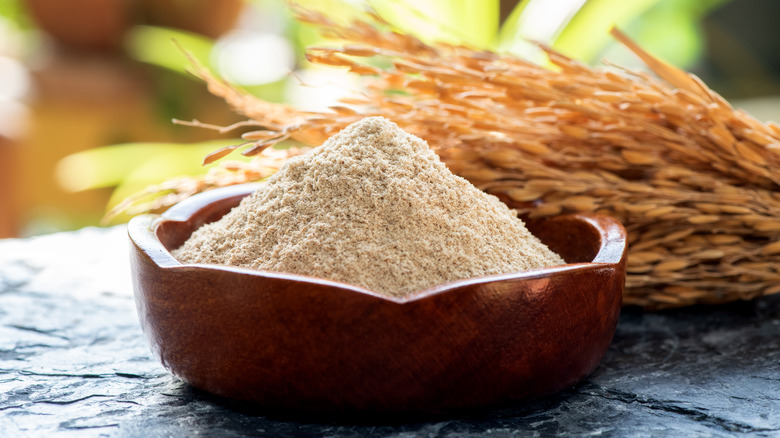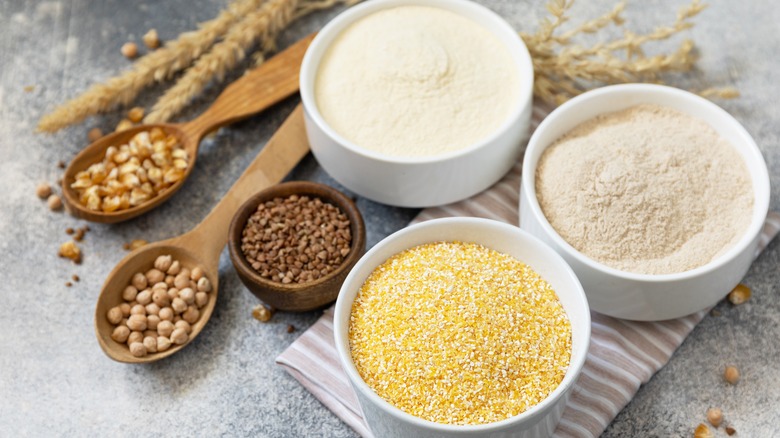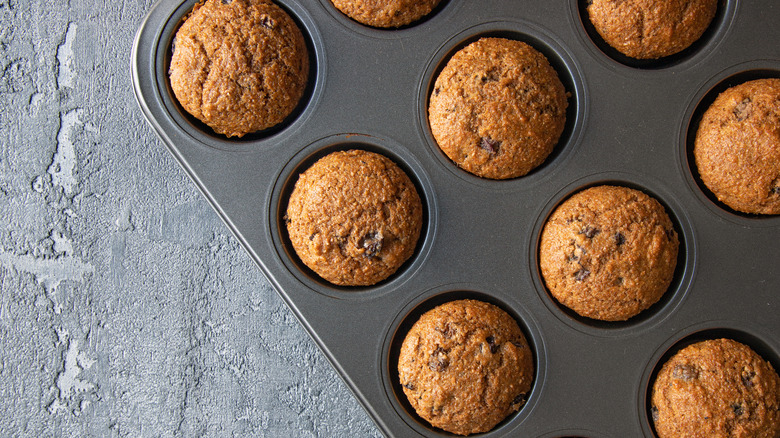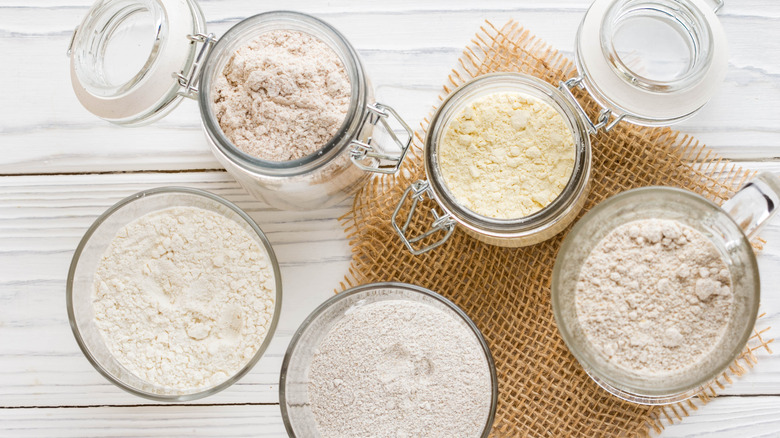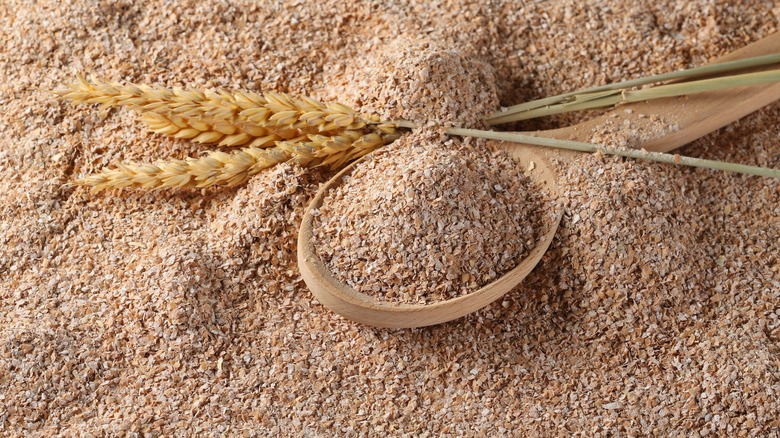What Is Bran And How Is It Different From Other Flour?
You might be familiar with it in your breakfast cereal or in that healthy muffin, but there's more to bran than you may think. The flaky, sawdust-like appearance of bran is often viewed as an offshoot of wheat that can boost the appearance and density of baked goods. However, bran is more than a baking additive — it's actually a form of flour.
If you've looked around online or on grocery store shelves, you might've noticed there's no shortage of flour these days, but with people having gluten sensitivity or other dietary reasons for skipping wheat, it's no surprise that there's an abundance.
Flour can be made from grains, including wheat, oats, or corn, and gluten-free flours can be made from non-grain items, like almonds, or vegetables such as zucchini and potatoes. This variety benefits anyone who doesn't eat grains and the cook who likes to change up their recipes since various flours can produce different results, ranging from a denser crumb to a richer flavor and texture. Since it can increase flavor, texture, and nutrition, bran is an excellent flour to add to your recipes.
What is bran flour made from?
To understand what makes bran flour different, it's helpful to know how traditional flour such as whole wheat and all-purpose flours are made, before we compare them to bran flour. In order to make all-purpose or whole wheat flour, both of which are made from wheat, the wheat plant is finely ground to make flour.
Where all-purpose and whole wheat flours differ is in what part of the wheat plant is ground up. All-purpose flour is made from wheat that doesn't contain any bran, also known as the hard outer layer of the plant, whereas whole wheat flour contains wheat bran. Since the outer layer often contains the most nutrients, all-purpose flour doesn't have the same nutritional value as flours that are made with the outer plant layers.
This is where bran flour is not only different, but some confusion can creep in when discerning what bran flour is. While wheat bran may be one of the most common forms of bran, it's important to understand that bran isn't a wheat derivative. Because many grain crops contain a similar type of outer layer, bran flour can be made from many plants from the grain family.
Grain plants are a type of crop that is categorized into two varieties: cereal grains and pseudo-cereal grains. The most common forms of cereal grains include oats, wheat, millet, rice, corn, rye, barley, and sorghum, while pseudo-cereal grains are quinoa, amaranth, and buckwheat.
What to make with bran flour
Bran is often used in baking since it can add texture, flavor, and nutrition to any baked item. It's also a highly versatile ingredient and can be used in almost any baked good recipe. Wheat bran is an ideal choice to add to muffins or bread, since it can aid in digestive health, due to its higher fiber content. Adding wheat bran to a recipe — be it for cookies, pancakes, or even homemade breadcrumbs — really comes down to taste and personal choice, but it can make for a heartier dish.
Although it can be used to replace some flour in recipes, oat bran is often made into a bowl of hot cereal or added to homemade granola bars. Like wheat bran, oat bran flour can also be included in cookies, bread, and muffins to increase fiber and nutritional value.
Other forms of bran flour that are easy to incorporate include rice bran, which can be added to homemade pizza dough or noodles, and corn bran, which has a neutral taste, making it suitable for baked goods without changing the flavor. And rye bran flour works best for bread, rolls, pretzels, bagels, and crackers.
Storing bran flour
Since the biggest way that bran flour differs from all-purpose flour is that bran flour hasn't been processed and stripped of the outer layers, these flours not only taste, look, and cook differently, but can also have a shorter shelf life. Most bran flours contain higher levels of oils naturally found within the grain, and that higher oil content means that bran flours are susceptible to spoilage much faster than all-purpose flour if they're not stored properly. Bran flours generally have a shelf life of up to eight months if kept in a cool, dark space and stored in an air-tight container.
Due to the number of oils in many bran flours, it can also be beneficial to store them in the freezer, to extend the shelf life even further and prevent the flours from going rancid. No matter which bran flour you decide to use, as long as you store it in the right way, you can use it in a number of recipes for months to come.
Is bran flour healthier than other flours?
Because bran is derived from many types of grains, the nutritional benefits can vary based on the grain used to create the bran flour. Bran is more nutrient dense than flours that have been refined, like all-purpose flour, but it can also contain higher levels of certain vitamins and minerals than unprocessed flours, such as whole wheat flour. A cup of whole wheat flour contains 14 grams of fiber and a cup of wheat bran contains 25 grams of fiber. Additionally, wheat bran is rich in iron, zinc, magnesium, potassium, and copper.
Like wheat bran, consuming oat bran is associated with increased health benefits. Oat bran contains vitamins E and B1, and phosphorus, an important mineral that helps keep muscles and nerves functioning regularly.
In addition to the additional vitamins and minerals found in oat bran, since it's derived from oats, oat bran takes longer to digest, which helps you feel full longer and can prevent spikes in glucose levels. With a variety of bran flours to choose from, including bran in your recipes is a relatively easy way to add nutrients and vitamins to your diet.
